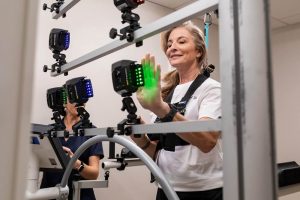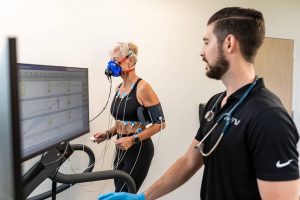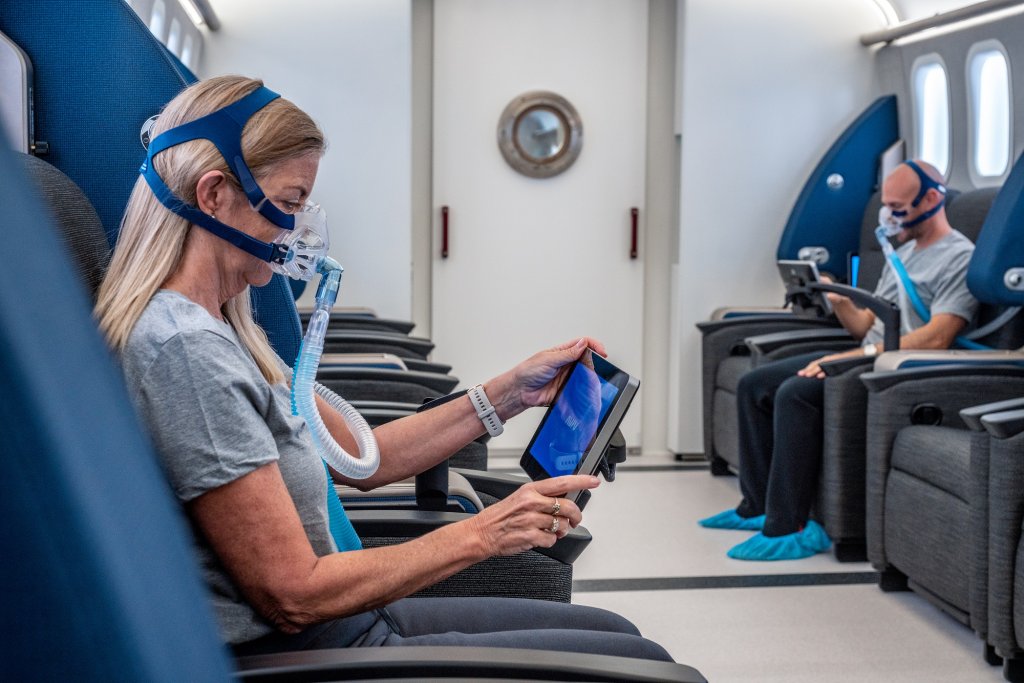How New Fibromyalgia Treatment Options Can Improve Quality of Life
Fibromyalgia is a very real condition, though it’s not uncommon for people who have it to experience misdiagnosis, feel misunderstood by their care providers, or receive ineffective treatment. This experience can be incredibly frustrating for those seeking relief from their symptoms.
Fortunately, new research offers access to revolutionary treatments that can better address fibromyalgia symptoms. Despite what some doctors believe, studies confirm that the experience of fibromyalgia patients is not “just in their heads.”
Now, new fibromyalgia treatment options can take a more targeted, holistic path.
What Is Fibromyalgia?
Fibromyalgia is a persistent, chronic pain disorder characterized by widespread musculoskeletal pain, sleep disturbances, fatigue, and impacts on cognitive function. There’s no singular cause of this condition. However, research indicates it is often “triggered or aggravated by multiple physical and/or emotional stressors,” including:
- Viral infection
- Traumatic brain injury (TBI)
- History of severe emotional stress
- Ongoing severe emotional stress
- Traumatic events
Despite its prevalence, finding a physician who truly understands the condition and can take proper measures to help you find relief can be exasperating and exhausting.

Traditional Treatments for Fibromyalgia
When managing fibromyalgia symptoms, the following treatment options are typically the first course of action to help people take control of their well-being. The treatments outlined are proactive and reactive measures that may provide some relief for fibromyalgia symptoms.
Lifestyle Changes
Lifestyle modifications may improve some fibromyalgia symptoms. These modifications can reduce the impact of symptoms like fatigue, low energy, poor sleep quality, and mood. Lifestyle changes often include establishing and practicing good sleep routines and eating a well-balanced diet.
Physical Therapy
Individuals living with fibromyalgia may experience chronic discomfort and ongoing, widespread pain. These symptoms can contribute to stiffness, soreness, and tension, among other bodily issues. Physical therapy can help reduce pain, using customized exercise programs to improve flexibility, strength, and endurance. Exercise can increase mobility and enhance general feelings of well-being.
Medications
Physicians sometimes prescribe medications to treat pain, improve sleep quality, or help regulate the psychological symptoms involved in the condition. Several medications, both over-the-counter and prescriptions, can play a role in managing fibromyalgia symptoms. Among those commonly used are:
- Pain relievers
- Antidepressants
- Anticonvulsants
Therapy or Counseling
Fibromyalgia brings new challenges that can be difficult to process. Professional emotional support can enhance your emotional well-being and help you cultivate a positive outlook on life, even in the face of chronic symptoms. Working with a compassionate therapist or counselor can go a long way toward developing helpful coping strategies and stress management skills.

New Fibromyalgia Treatments
Traditional treatments can do a lot to relieve day-to-day fibromyalgia symptoms. However, more advanced, comprehensive solutions go beyond addressing the surface-level effects of the condition.
New fibromyalgia treatment solutions go deeper to provide long-lasting relief and empowerment to those dealing with symptoms. These therapies look at the underlying mechanisms associated with how the condition manifests.
Stress Management Activities
Recent research has shown that the condition has a psychiatric element and that exposure to psychosocial stressors may “contribute to dysfunctional pain processing.” Because abnormal pain perception can be exacerbated by stress, the following Stress management strategies like the following can be powerful ways to address fibromyalgia symptoms:
- Meditation
- Deep breathing
- Enjoyable hobbies
- Massage
- Yoga and tai chi
It’s critical to note that people can have a range of experiences with stress. In one study, 75% of participants engaging in a mindfulness-based stress reduction (MBSR) practice reported “experiencing a reduction in symptom severity.” In other studies, there’s “no evidence that mindfulness had an effect on other variables, such as positive mood, attention, sleep.”
Hyperbaric Oxygen Therapy (HBOT)
Another new treatment for fibromyalgia has promising results, as published in peer-reviewed studies. These trials indicate that a unique, evidence-based hyperbaric oxygen therapy (HBOT) protocol (involving breathing fluctuating levels of pure oxygen in a pressurized chamber) can increase oxygen levels in the body’s tissues and trigger the body’s natural self-healing mechanisms.
The HBOT process helps promote tissue healing, reduce inflammation, and enhance brain and body performance. This treatment provides the following support:
- Less fatigue
- Reduced brain fob
- Decreased pain
- Boosted energy level
- Improved cognitive function
- Increased brain connectivity
- Improved sleep quality
Restoring Hope with a Groundbreaking Fibromyalgia Treatment at DP World’s Aviv Clinics Dubai

HBOT treatment is non-invasive, targeting the regions of the brain and body responsible for pain sensation and tolerance to enhance feelings of well-being.
The HBOT protocol used in the aforementioned studies is the same protocol employed in the state-of-the-art hyperbaric suites at Aviv Clinics. For Patty, this solution was life-changing.
“By halfway through, I didn’t have the pain or the aches anymore…I didn’t feel like I had the fatigue. I had so much energy. I have a clear brain now… I just feel like I have a whole new brain.” — Patty, Aviv Clinics Fibromyalgia patient
Watch Patti’s Story: Healing from Fibromyalgia
Future Outlook and Potential Impact on Fibromyalgia Patients
As new fibromyalgia treatment options continue to offer a greater understanding of the condition and better results, the outlook is increasingly promising. If you’re dealing with the effects of fibromyalgia, there is hope for a reduction in symptoms.
Since fibromyalgia symptoms can vary from person to person, a targeted, personalized program that addresses the underlying mechanisms of the condition is key to more comprehensive, effective management. At Aviv Clinics Dubai, each prospective client receives a personalized treatment program, based on the clients’ individual needs and health concerns, and the results of a comprehensive physical, medical, and cognitive assessment.
The Aviv Medical Program is a holistic treatment plan that can include the following:
- Cognitive training
- Dietary coaching
- Physical performance training
- Hyperbaric oxygen therapy (HBOT)


There is renewed hope as we make new strides toward understanding fibromyalgia.
Advancements in medical science have paved the way for new fibromyalgia treatment options designed to alleviate symptoms and empower individuals to reclaim their quality of life. Taking a multi-dimensional approach, the team at Aviv Clinics Dubai improves outcomes for people with fibromyalgia.
We strive to make a significant difference in fibromyalgia symptoms so those living with the condition can experience relief and take charge of their quality of life.
You don’t have to suffer alone, feeling misunderstood and misdiagnosed.
We can help you achieve real relief.
Chronic Pain and Its Causes
Chronic pain is one of the most common reasons why people seek medical care today. It’s also a leading cause of disability. Chronic pain can be debilitating when it’s severe enough. Many people who suffer from it experience a loss of mobility, leaving them unable to leave their homes or even their beds. While chronic pain this intense is rare, even less severe pain can leave you unable to enjoy activities you once loved, potentially leading to isolation and mental health problems like depression.
According to the CDC, nearly 1 in 5 adults in the United States suffer from chronic pain. The older population is hit especially hard because the risk of chronic pain increases with age. Adults aged 65 and older experience the most chronic pain of any demographic. Older adults also are more likely to experience high-impact chronic pain, which can severely impact their quality of life.
Fortunately, there is hope. While there’s a lot about chronic pain that we still don’t understand, we’re gaining more knowledge every day. We’re also learning how to treat it effectively, so that those who suffer from it can live full lives. Here’s a basic overview of what chronic pain is and where it comes from.
What is pain?

In its most basic sense, pain is a sensation of discomfort created by the brain in response to unpleasant stimuli. If you stub your toe on a table leg, the nerve endings in your toe will fire and send a signal to your brain, telling the brain that it’s been hurt. The brain then emits a signal back through your body, which you experience as pain.
This particular type of pain is known as acute pain, and it’s actually a good thing.
Acute pain is a survival mechanism. If you never felt pain, then you would not know that your body was injured. Say you get a cut to the back of the thigh. If you couldn’t visibly see the injury, how would you know that your body had suffered an injury? You could die of an infection before you realized anything was wrong!
Acute pain is nature’s way of making us pay attention to our injuries. It alerts us to stop and take care of ourselves before we suffer further harm. The good thing about acute pain is that it usually disappears without a trace once the injury has healed. Chronic pain, on the other hand, is a different story.
What is chronic pain?
Unlike acute pain, chronic pain persists after an injury or illness heals. Chronic pain outbreaks can last for months or years on end and often show no signs of disappearing. The sensation can vary from sharp and stabbing, like a migraine, to dull and throbbing like an old ache in your bones.
Everyone experiences chronic pain in different ways. There is no standard sensation or unifying characteristic.
This is why the classic 1-10 “pain scale” isn’t always an effective tool to gauge how much pain a person is suffering. Pain is a subjective experience. One person’s 5 may be another person’s 8. We all experience different thresholds for pain. And we all experience different causes for that pain. Here are a few possible explanations about where chronic pain comes from.
What causes chronic pain?

- 1. A reaction to acute pain
Chronic pain may be caused in response to acute pain, like a lingering ache in your back after pulling a disc. Doctors and patients alike often mistake chronic pain for acute pain at first, because it may appear that chronic pain is simply the re-emergence of an old injury. But chronic pain is a pain that has taken on a life of its own.
While we don’t currently understand exactly why acute pain sometimes shifts into chronic pain, it is clear that the presence of acute pain can spur chronic pain, even after the injury in question has healed.
- 2. Chronic illness
Just like with acute pain, chronic pain may be brought on by a condition like Lyme disease, fibromyalgia, sciatica or arthritis. Older adults are more likely to suffer from chronic illnesses than younger adults. Common side effects of chronic illnesses include fatigue, aches, migraines and nerve pains. Certain types of cancer can also cause chronic pain, as can cancer treatment methods like chemotherapy or surgery.
- 3. Mental health problems
Chronic pain is also common in people who suffer from mental health problems like depression and anxiety. It’s not currently clear whether depression itself causes chronic pain, or chronic pain causes depression. Given what we know about the mind-body connection, however, it’s likely that having one condition can worsen the other.
If you feel depressed, then you’re more likely to experience chronic pain more intensely. If your pain is so intense that you can no longer leave your home, then your depression can worsen from the isolation, creating a vicious cycle.
- 4. No obvious cause
Sometimes, there’s no clear cause for chronic pain at all, which can be all the more frustrating for someone who suffers from it. It’s easy for someone with chronic pain to feel powerless to the world around them. However, that doesn’t have to be the case. There are plenty of different ways to manage chronic pain without addictive medications and opioids.
A multi-pronged approach to chronic pain relief

In the past, it was common for doctors to prescribe opioids as a solution for patients with chronic pain. But while medication can be an effective way to handle chronic pain in the short term, using opioids alone is unlikely to give you the relief that you want. In fact, it may do more harm than good. Opioids are extremely addictive. Using them for too long can create a dependence that can put users at risk for dangerous side effects and deadly overdoses.
One of the most effective ways to manage chronic pain is through a multi-pronged approach of hyperbaric oxygen therapy, proper nutrition, physical activity, and psychological / cognitive aid. Hyperbaric oxygen therapy, such as the type offered at Aviv Clinics in Dubai. This unique approach has also been shown to be effective in managing chronic pain from conditions like fibromyalgia.
To learn more about Aviv Clinics – brought to you by DP World, contact the clinics today.
Hyperbaric Oxygen Therapy Decreases Chronic Pain Associated with Fibromyalgia
Fibromyalgia is a chronic complaint commonly associated with musculoskeletal pain fatigue, non-restorative sleep, and other symptoms impacting on mood and memory, Fibromyalgia affects approximately ten million Americans. Globally, estimates range between 3% and 6%, predominantly women.
Enduring pain disorders, and Fibromyalgia specifically, result from a defective nervous system. Fibromyalgia is not congenital; instead, symptoms develop over time, often as a reaction to external influences including infection, physical trauma, or emotional factors. However, it is unclear and frequently impossible to determine what activates the condition.
HBOT as Therapy for Fibromyalgia
Fibromyalgia doesn’t directly impact the muscles or joints; rather, it affects the manner nerves interpret and communicates pain messages to the brain. Consequently, pain thresholds are much lower, complicating effective treatment. In the absence of physical therapy such as fixing a torn tendon, the standard therapeutic reaction is to treat these ailments pharmaceutically. However, non-prescription pain relievers aren’t sufficiently strong enough to effectively provide relief. Prescription pain relievers, including opioids, decrease in their effectiveness over time and carry many other risks, not least addiction.
In the search for non-pharmaceutical solutions, hyperbaric oxygen therapy (HBOT) is being investigated as a potential treatment for chronic pain complaints. The Canadian Agency for Drugs and Technologies in Health (CADTH), an autonomous agency charged with sourcing, reviewing, and précising clinical research into new medicines and medical devices. Recently, the Agency published a detailed study HBOT as a potential therapy for chronic pain in adults.
The resultant article “Hyperbaric Oxygen Therapy for the Treatment of Chronic Pain: A Review of Clinical Effectiveness and Cost-Effectiveness,” CADTH examined multiple studies. Sixty women with Fibromyalgia were examined in one study. They were treated with HBOT sessions of five days 12 weeks. It determined that HBOT therapy elevated pain increased pain thresholds and other quality of life indicators whilst lowering the quantity on of tender points and emotional stress. Following treatment, single-photon emission computed tomography (SPECT) imaging showed that parts of the brain that had previously revealed abnormalities had normalized.

Hyperbaric Oxygen Therapy (HBOT) a potential treatment for chronic pain.
A different study assessed 30 myofascial pain syndrome sufferers — an acute pain disorder affecting the muscles and connective tissues. These patients were treated with HBOT sessions five days per week for only a fortnight. Notwithstanding this brief timeframe, HBOT boosted pain thresholds whilst decreasing physical and mental dysfunctions.
The data was uncertain concerning the cost benefits. Though the CADTH report was equivocal as to the cost-effective of HBOT over prescription pain killers, there was much greater certainty that HBOT is the safer of the two.
The limited period of these studies of HBOT therapy means that more extensive research is needed to explore further potential and confirm the conclusions. Early indications, however, were very encouraging.
